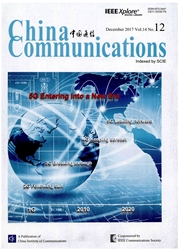

 中文摘要:
中文摘要:
In this paper,we investigate the matched filter based spectrum sensing in a more reasonable cognitive radio(CR) scenario when the primary user(PU) has more than one transmit power levels,as regulated in most standards,i.e.,IEEE 802.11 Series,GSM,LTE,LTE-A,etc.This new multiple primary transmit power(MPTP) scenario is specialized by two different targets:detecting the presence of PU and identifying the power level.Compared to the traditional binary sensing where only the presence of PU is checked,SU may attain more information about the primary network(making CR more 'intelligent') and design the subsequent optimization strategy.The key technology is the multiple hypothesis testing as opposed to the traditional binary hypothesis testing.We discuss two situations under whether the channel phase is known or not,and we derive the closed form solutions for decision regions and several performance metrics,from which some interesting phenomenons are observed and the related discussions are presented.Numerical examples are provided to corroborate the proposed studies.更多还原
 英文摘要:
英文摘要:
In this paper,we investigate the matched filter based spectrum sensing in a more reasonable cognitive radio(CR) scenario when the primary user(PU) has more than one transmit power levels,as regulated in most standards,i.e.,IEEE 802.11 Series,GSM,LTE,LTE-A,etc.This new multiple primary transmit power(MPTP) scenario is specialized by two different targets:detecting the presence of PU and identifying the power level.Compared to the traditional binary sensing where only the presence of PU is checked,SU may attain more information about the primary network(making CR more "intelligent") and design the subsequent optimization strategy.The key technology is the multiple hypothesis testing as opposed to the traditional binary hypothesis testing.We discuss two situations under whether the channel phase is known or not,and we derive the closed form solutions for decision regions and several performance metrics,from which some interesting phenomenons are observed and the related discussions are presented.Numerical examples are provided to corroborate the proposed studies.
 同期刊论文项目
同期刊论文项目
 同项目期刊论文
同项目期刊论文
 期刊信息
期刊信息
